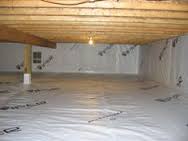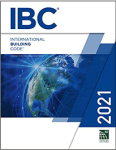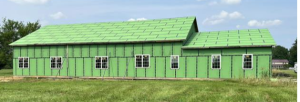One of our clients has been erecting a post frame home in Colorado Springs, which is over a crawl space. Here is our discussion in regards to insulating the crawl space.
“While I have your ear, I had asked you a question earlier about getting the code required R30 in the 2×6 floor joists of my raised floor. I looked into your suggestion of spray foam and I got some quotes from local companies and I was shocked! One company quoted me $16,000 to do 3″ in the floor and walls with some performance charts showing that the 3″ would satisfy the code (I’m a bit skeptical). I got another general quote of $1.10/board foot and that it would take 5″ (i.e. $5.50 / sq ft) or $12,650 just for the floor. The second company did suggest though that El Paso county allowed the R30 around the crawl space perimeter and no insulation in the floor… which leads me to my question…
 What would be your thoughts of a non-vented crawl space using something like 15 mil plastic on the ground and up the sides the 18″ to the floor and the R30 spray foam from the ground to the floor level? I could get that done for around $2500. I’m still haven’t completely decided if I will used dense pack cellulose or BIBs for the walls but I’m pretty sure I don’t have the budget for spray foam in the walls.”
What would be your thoughts of a non-vented crawl space using something like 15 mil plastic on the ground and up the sides the 18″ to the floor and the R30 spray foam from the ground to the floor level? I could get that done for around $2500. I’m still haven’t completely decided if I will used dense pack cellulose or BIBs for the walls but I’m pretty sure I don’t have the budget for spray foam in the walls.”
Mike the Pole Barn Guru Responds:
When I moved to Oregon from Eastern Washington in 1979, I was amazed at how different the construction techniques were from what I had grown up with. Eastern Washington was the land of full basements, whereas Western Oregon was predominately crawl spaces. The typical crawl space would have 6 mil black visqueen draped down the sides of the foundation and covering the ground, with R-19 unfaced batts used to insulate directly beneath the floors.
A variant of this was to use the crawl space as an air plenum, eliminating the need for heat ducts, and placing the unfaced insulation against the foundation.
This variant is basically a very slight spin away from what you propose to do.
Performance charts always frighten me as they general require some hocus pocus involving dead air space. Closed cell spray foam is R-7 per inch, so a claim of three inches in a system making R-30 sounds bogus unless the balance of the cavity is going to be filled with something like unfaced fiberglass batts. There is no question about closed cell spray foam being expensive, even the work I had done when we added the elevator shaft on the back of our home ran $2.80 per square foot for four inches thick.
Personally, I have no issues with what you propose to do and would probably take it a step further and utilize the principles of Frost Protected Shallow Foundation insulation below the base of my wall steel. https://www.hansenpolebuildings.com/2016/11/frost-protected-shallow-foundations/.










2X6 floor joints?? must be a very short span or soft floor.
Anyway, as someone who is “frighting” mold in a crawl space, I agree completely with the FPHF recomendation.
I don’t know how wet it is where the building is, but I’d recommend some research on preventing mold in the crawl space.
Hint – making it part of the conditioned space is about all that works.
Also, if you can, poor a rat slab to seal and make working in the crawl space easier.
Residential floors are to be designed for a 40 psf (pounds per square foot) live load, other than sleeping rooms which can be designed for 30 psf. Using a 50 psf total load, Hem-Fir #2 floor joists can be used to span 9’1″ spaced 16″ o.c. (on center) or 7’11” spaced 24″ o.c. and meet Code requirements for deflection.
It is difficult to overstate the problems associated with crawl space moisture. Reasons why excessive moisture is a bad thing:
Mold, Mildew: The main problem is mold, fungi, and mildew. Remediating mold-related problems is expensive. While in some cases mold problems are blown all out of proportion, as a direct byproduct of crawl space moisture it will begin blackening floor cavity insulation and structural elements. Because there is no light and only minimal ventilation, the problem never improves on its own.
Rot: Structural elements of your house–joists, sills, posts, beams–are made of wood. Being an organic material, non-pressure preservative treated wood will begin to rot when it comes into contact with water.
Creatures: Animals of all types are drawn to water and can infest your home. This includes rats, carpenter ants, and termites.
Resale: Even if moisture did not create those problems above, its presence will turn away home buyers. When you try to sell your house, the property inspector will explore the crawl space and note the presence of water on the report. It does not matter if you have contentedly lived in your home like this for 20 years–the buyer will want the problem fixed or demand a credit.
The best way to prevent mold, mildew and a musty crawl space is to encapsulate it. The science behind encapsulating or sealing your crawl space is simple: by removing the source of the moisture, which mold and mildew thrive in, you’ll prevent and minimize mold growth.
Here’s how it works. A thick 20-mil barrier – think of it like an industrial pool liner – is placed over your crawl space floor and walls. This seals your crawl space from any moisture which may leak up from the dirt floor or through wall cracks. Finally, all entrances and vents are sealed, protecting your crawl space from any water or humidity which may come through open vents and doors.
In some cases a dehumidifier is necessary to help keep your crawl space dry. As you know, a dehumidifier removes any extra moisture from the air, which helps prevent mold growth.
Water From Below: When large amounts of water pool up in the crawl space, you may have a ground water problem or a problem with rainwater intrusion. In this case, dig a trench around the perimeter, add drain pipe, cover with drain gravel, and add a sump pump.
A rat slab is a very thin layer of non-structural concrete poured over the dirt floor of a basement or crawlspace. As the name implies, it is intended primarily to prevent the intrusion of pests into the area below a building. They also make such spaces much cleaner and more pleasant to work in. Rat slabs are generally 1 inch or less in thickness.
in Washington for rat slab cod is 6mil or better and 3”concrete!
Can you please share a link to this part of the Code, as we have not seen it.